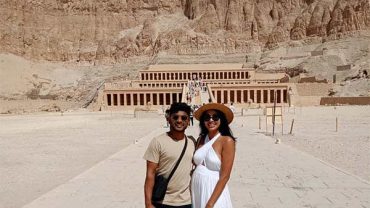Step back in time and immerse yourself in the captivating narrative of Karanis – Kom Oushim, an archaeological wonder that echoes the tales of ancient Egypt. Located in the heart of the fertile Fayum region, this site serves as a time capsule, preserving the remnants of a bygone era. The name “Karanis” resonates with historical significance, reflecting the rich tapestry of this ancient settlement. As we embark on this journey through time, let’s unravel the mysteries and explore the profound heritage that lies within the layers of Karanis – Kom Oushim.
Historical Significance
Karanis – Kom Oushim stands as a testament to the thriving Greco-Roman civilization that flourished in Egypt during the Hellenistic and Roman periods. Established around the 3rd century BCE, this archaeological site unveils a once-vibrant community that seamlessly blended Egyptian and Greco-Roman influences. The ruins reveal intricate details of daily life, showcasing the ingenuity of ancient engineering and the cultural amalgamation that defined the region. From well-preserved houses to remnants of a once bustling marketplace, every stone narrates a story, providing a glimpse into the daily lives of the people who called Karanis home.
Architectural Marvels:
The architectural prowess displayed at Karanis – Kom Oushim is nothing short of awe-inspiring. The site boasts a fascinating array of structures, including temples, houses, and public buildings. The Temple of Kom Oushim, dedicated to the crocodile god Sobek, stands as a majestic testament to ancient religious practices. The meticulous craftsmanship displayed in the construction of these edifices reflects the sophistication of ancient Egyptian and Greco-Roman architectural techniques. As you wander through the remnants of colonnades and courtyards, you can’t help but marvel at the precision and artistry that define these structures, transporting you to an era where every stone was a canvas for cultural expression.Explore also History of Egypt.
Daily Life in Karanis:
Peering into the daily life of Karanis unveils a fascinating mosaic of activities and traditions. The houses, adorned with colorful frescoes and intricate mosaics, offer a glimpse into the domestic life of the residents. The marketplace, once a bustling hub of commerce, whispers tales of trade and economic exchanges. Agricultural practices, evident in the remnants of granaries and storage facilities, highlight the importance of farming in sustaining this ancient community. As you walk through the streets of Karanis, the echoes of laughter, the aroma of daily meals, and the hum of daily activities come alive, providing a holistic view of a society deeply rooted in its cultural fabric.
Rediscovery and Preservation:
Rediscovering Karanis – Kom Oushim was not just an archaeological endeavor but a commitment to preserving the cultural heritage of Egypt. Excavations led by dedicated teams have unearthed invaluable artifacts, allowing us to piece together the puzzle of this ancient settlement. The meticulous conservation efforts ensure that future generations can continue to explore and appreciate the wonders of Karanis. Today, the site stands as a living testament to the importance of preserving our historical roots, offering a bridge between the past and the present for all those curious minds eager to delve into the mysteries of antiquity.
Cultural Fusion:
One cannot explore the wonders of Karanis – Kom Oushim without acknowledging the fascinating cultural fusion that defines this ancient settlement. The city served as a melting pot where Egyptian and Greco-Roman traditions intermingled, giving rise to a unique tapestry of customs and beliefs. This cultural amalgamation is evident not only in the architectural marvels but also in the artifacts discovered at the site. From pottery adorned with intricate patterns to religious symbols that reflect syncretism, every artifact tells a story of a community that embraced diversity and celebrated its cultural hybridity. Karanis emerges as a testament to the idea that cultural exchange has been an integral part of human civilization since time immemorial.
Archaeological Revelations:
The excavation of Karanis – Kom Oushim has been a journey of archaeological revelations, unveiling secrets that lay buried for centuries. The meticulous work of archaeologists has brought to light a treasure trove of artifacts, including household items, religious relics, and tools that provide insights into the daily lives and practices of the ancient inhabitants. Each artifact becomes a puzzle piece, contributing to our understanding of the social, economic, and religious dynamics that shaped Karanis. The archaeological revelations not only enrich our historical knowledge but also serve as a source of inspiration for future exploration, urging us to delve deeper into the mysteries that still lie beneath the layers of time.
Environmental Context:
To truly appreciate the significance of Karanis – Kom Oushim, one must consider the environmental context that influenced its development. Situated in the fertile Fayum region, the city thrived due to the agricultural bounty provided by the nearby Lake Moeris. The fertility of the land facilitated a flourishing community engaged in farming, fishing, and trade. The careful integration of natural resources into the daily life of Karanis underscores the symbiotic relationship between the people and their environment. Exploring the environmental context allows us to grasp the resilience and adaptability of ancient civilizations, drawing parallels to contemporary challenges in sustainable living.
Legacy and Educational Value:
The legacy of Karanis extends beyond the physical ruins and artifacts; it holds immense educational value for present and future generations. The site serves as an open-air classroom, offering a tangible connection to the past for students and scholars alike. The lessons derived from Karanis encompass not only historical and archaeological insights but also foster an appreciation for cultural diversity and the importance of preserving our heritage. Educational initiatives centered around Karanis – Kom Oushim provide a platform for fostering curiosity, critical thinking, and a sense of stewardship for our shared human legacy.
Community Engagement:
The story of Karanis is not confined to the pages of history books but is intertwined with the present-day communities that surround it. Community engagement plays a crucial role in preserving and promoting the site’s cultural significance. Collaborative efforts between archaeologists, local communities, and government authorities ensure that the benefits of understanding and protecting Karanis are shared by all. By involving the community in the preservation process, we foster a sense of pride and ownership, creating a sustainable model for the safeguarding of cultural heritage that transcends generations.




Comment (0)